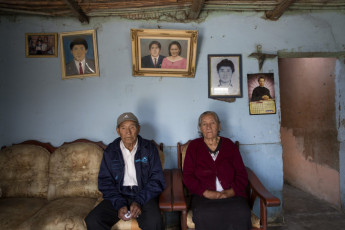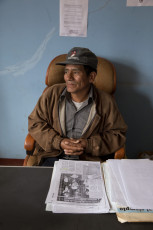
Reynalda Andagua Gonzales talks about her son, Martín Roca Casas, who disappeared in 1993. Javier Roca, Martín’s father, appears in the mirror next to an altar dedicated to the memory of his son. “He was kidnapped, tortured, murdered and incinerated during the government of Alberto Fujimori”. Lima, 2009

Peru’s ex-President Alberto Fujimori was tried in Lima for human rights violations. Here he was sentenced to twenty-five years in prison for the La Cantuta and Barrios Altos massacres. Lima, July 16, 2008

During a commemorative march on the sixteenth anniversary of the La Cantuta massacre, family of the nine students and one professor who were kidnapped and then executed, carry coffins containing the remains of their loved ones. The massacre took place during the presidency of Alberto Fujimori. Lima, July 18, 2008

The Peruvian army killed most of Julián Ricra Huamani’s family during the 1980s, in the context of their counter insurgency against the Shining Path in the Andes Mountains. To escape the violence, he fled to the capital nearly twenty years ago. Pamplona Alta, Lima, 2009

Marina Allccaco’s brother was disappeared in the 1980s by the military. Hualla, Ayacucho Region, 2009

Juana Crisante de Méndez holds the military service ID that belonged to her husband, Fortunato Méndez Huamancusi. Fortunato was detained and then disappeared from the Canaria military base near Hualla in 1984. Ayacucho Region, 2009

In the village of Challhuamayo, located at an elevation of 14,107 feet (4,300 m) in a remote area of the Peruvian Andes. In the 1980s and 1990s this region was ravaged by the violence of the brutal internal armed conflict between the Shining Path and the Peruvian military. Ayacucho Region, 2009

Since the middle of the 1980s Saturna Chocce Valencia has lived and worked on this farm. Saturna is one of only two survivors of the Putka massacre, where forty men, women and children were killed by ronderos, members of a Self-Defense Committee who were supported by the military. Huanta, Ayacucho Region, 2009

Benadicta Inca’s husband, Bernardo Ipurre Tacsi, was disappeared by the military in 1984. Hualla, Ayacucho Region, 2009

Emiliana Auccasi’s husband, Diomedes Cayampi, was disappeared by the Shining Path in December 1990. She wants to find the remains of her husband. Sacsamarca, Ayacucho Region, 2011

Wilbur Bautista with his wife and son. Wilbur’s father, Víctor Bautista, disappeared in 1989. Putaccasa, Ayacucho Region, 2011

The exhumation of the remains of Teófilo Palomino. Seven men were killed here by the Shining Path in 1984. Pucamarca, Ayacucho Region, 2012

Marly Anzualdo with items that belonged to her brother, Kenneth Anzualdo. Kenneth was disappeared by police in 1993, while studying at the Universidad Nacional del Callao. Lima, 2012

One of the sectors of the Manchay District in Lima, where 45,000 people currently live. The vast majority of them are displaced people from the Andes, survivors of the violence and their children and grandchildren. Lima, 2013

Jorge Noriega, with a photograph of his son, Jesús, one of nine men who were disappeared and then killed in 1992 by the Grupo Colina, a death squad that operated during the government of Alberto Fujimori. Santa, Ancash Region, 2013

Alejandro Castillo and his wife, Rosa Chávez de Castillo, parents of Denis Atilio Castillo Chávez. Denis was one of the nine people detained and killed on May 2, 1992 by the Grupo Colina. Santa, Ancash Region, 2013

On the side of the Pan-American Highway, Otilia León Velásquez, the sister of Gilmar Ramiro León, looks at the crosses that mark the spot where, in 2011, the remains of Gilmar and the other eight men were found and exhumed in 2011. Huanca Corral, Santa, 2013

After the remains were handed over in the EPAF office, family members of some of the victims of the Parcco-Pomatambo massacre carry the coffins along a street in the Jesús María district in Lima. 2013

Reiner Ipurre with his daughter. Reiner is the son of Benadicta Inca (9/30). His father, Bernardo Ipurre Tacsi, was disappeared in 1984 in Hualla, in the Ayacucho region. Lima, 2013

A woman who belongs to an evangelical church calls the children to come listen to Bible stories. Villacuri is a community of people displaced from the Andes on the south coast of Peru near the city of Ica. Santa Cruz de Villacuri, Ica, 2014

Floriano Guillen and his wife, Victoria, remember how in 1986 soldiers detained and tortured Floriano and another man. Victoria went after them with her baby on her back, but a soldier struck her with the butt of his rifle, she fell onto her back and the baby was killed. San Francisco, Ica Region, 2014

Ezequiel Baldeón with documents regarding his parents’ case. In 1985, soldiers took his father to a military base. Three days later, his mother was detained and disappeared as well. Accomarca, Ayacucho Region, 2014

Benita Pariona de Arango (on the left) in her house with her daughter and some of their neighbors. In 1984 soldiers killed Benita’s husband, Filemón Arango Soca. Seven years later the Shining Path killed her oldest son. Another of her sons was killed by the police. Ñuñunhuaycco, Ayacucho Region, 2014

A woman in her store with a family member. She is making a weaving for the memory of her hometown, Putaccasa, where she was raped during the years of violence. The Shining Path burned down Putaccasa twice, in 1984 and in 1992. Sacsamarca, Ayacucho Region, 2014

An exhibition of clothing found in the exhumations carried-out in La Hoyada, part of the Cabitos Military Base. Pampa Cangallo, Ayacucho Region, 2014

The people of Huamanquiquia lived though a decade of intense political violence: first in 1983, the Shining Path killed twelve people. The following year the military killed eighteen farmers. Almost ten years later, the Shining Path executed eighteen people from the town. Ayacucho Region, 2014

Sebastiana Vivanco lost her husband on July 1, 1992, when Shining Path militants pretending to be soldiers entered the village and proceeded to torture and kill 18 men. They hit the women, cut-off their braids, and forced them to prepare food. Huamanquiquia, Ayacucho Region, 2014

Huamanquiquia, Ayacucho Region, 2014

Huamanquiquia, Ayacucho Region, 2014

Mélida Contreras de Cantoral, Saúl Cantoral’s widow, in the office of the miners’ labor union of Shougang Hierro Peru. Saúl Cantoral was kidnapped and killed in Lima on February 13, 1989, by a Paramilitary Cell created by the government at the time. Marcona, Ica Region, 2016